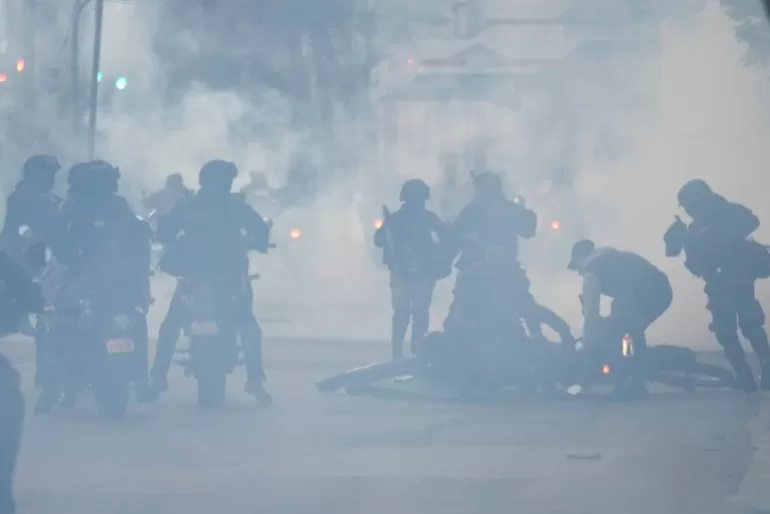Anti-government protesters have clashed with supporters of President Luis Arce in Bolivia’s capital, La Paz, as fears grow of further unrest in the Andean nation mired in an economic crisis ahead of next year’s presidential election.
Riot police and supporters of Arce gathered to defend the government on Monday evening in the Plaza Murrillo, the central square in La Paz where the main presidential and legislative offices are located, raising fears of a major confrontation.
Tensions rose as former President Evo Morales spoke to a large crowd and demanded that the government make cabinet changes “within 24 hours”, or face the wrath of thousands of protesters who he has led in a week-long march.
Morales declared that Bolivians had had “enough of betrayal and above all enough of corruption, protection of drug trafficking and economic mismanagement”.
Bolivia’s foreign ministry on Tuesday rejected the ultimatum by Morales, saying in a statement that the ex-president had threatened the country’s “democratic order”.
For the last two days, acrid smoke from burning tyres and thick clouds of tear gas have filled the streets of El Alto, a sprawling city on a plateau above the capital.
Protesters on each side have hurled firecrackers, homemade explosives and stones at each other, and riot police have fired tear gas into the crowds.
Clashes between supporters of Morales and Arce have left 34 people injured, according to the authorities.
Left-wing rivals
Arce and Morales were once close allies, but are now vying to lead Bolivia’s long-dominant party Movement Toward Socialism, known by its Spanish acronym MAS, ahead of the 2025 presidential vote.
In recent months, their power struggle has paralysed the government, exacerbated the depletion of Bolivia’s foreign-exchange reserves and fuelled street protests.
Arce, who served as minister of the economy for many years under Morales, earlier this year denounced a supposed military coup attempt, which he blamed on his former ally.
On Sunday, Arce said in a televised message that he would not grant Morales “the pleasure of a civil war”.
Morales is seeking to make a political comeback after he was thrown out of office in 2019 over alleged election fraud and was briefly forced into exile. But he is currently barred by the constitution from running for another term.
The standoff raised comparisons to previous governments that were toppled by mass protests, including those leading to the 2003 resignation of former President Gonzalo Sanchez de Lozada.
“It’s premature to think of a resignation,” said Jose Manuel Ormachea, a political scientist and member of Bolivia’s parliament affiliated with the opposition Citizen Community party, which also rejects Morales’s bid for another term.
“The fall of [Sanchez de Lozada] came about when the police joined the people against the government and the military. Today, there is no sign that the police or the military have considered abandoning Arce and joining Evo,” he told Al Jazeera.
After the ultimatum from Morales, it’s unclear what happens next.
“This was a massive show of force by Evo. He showed his ability to mobilise nationally,” said Eduardo Gamarra, a Bolivian-born political scientist at Florida International University (FIU) in the United States.
“But it remains to be seen if Morales has enough strength to march on Plaza Murillo and enter the palace,” he added, referring to the legislative building in the city centre next to presidential offices.
Poverty rate
Since Morales returned from exile in 2020, he has retained widespread support among poor and Indigenous Bolivians, who represent almost half the country’s population of 11 million.
In 2021, the World Bank reported that 36.4 percent of Bolivia’s population lived in poverty, and 11.1 percent lived in extreme poverty.
Meanwhile, Arce’s government has been hit by a drop in revenue from natural gas exports, coupled with a decline in production due to a lack of investment nationally.
To compensate, the president has been using international reserves to maintain domestic subsidies, which in turn has led to a dollar shortage and the devaluation of the Bolivian peso.
Morales has used the economic crisis as a political weapon to promote his campaign for another presidential bid, rallying his loyal base of coca farmers, Indigenous peoples and workers who have come to his defence with street protests, marches and road blockades.
Thousands of Bolivians last week began a 200km (124-mile) “March to Save Bolivia” in an apparent effort to pressure the Arce government.
The marchers stopped Sunday – their sixth day of walking – to sleep at an encampment near El Alto, a city of almost one million mostly Indigenous residents that sits high above the capital.
Morales has sought to portray the march as a reflection of Bolivia’s Indigenous highland culture as much as a political challenge to the Arce government, with his supporters bearing multicoloured flags of the Indigenous Andean movement that the left-wing leader has turned into a patriotic symbol.
Each side has blamed the other for the recent violence. Morales accused Arce’s government of deploying “paramilitary groups to incite violence” and busing officers into El Alto to stir up trouble — a claim echoed by Bolivia’s ombudsman.
“It’s very sad that this government doesn’t pay attention to its conscience,” said Benita Cruz, a Morales supporter at the scene of Sunday’s clashes. “They are repressing the poor and most humble people.”
